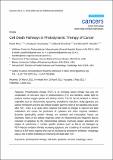| dc.contributor.author | Mroz, Pawel | |
| dc.contributor.author | Yaroslavsky, Anastasia | |
| dc.contributor.author | Kharkwal, Gitika B. | |
| dc.contributor.author | Hamblin, Michael R. | |
| dc.date.accessioned | 2014-06-24T14:11:20Z | |
| dc.date.available | 2014-06-24T14:11:20Z | |
| dc.date.issued | 2011-06 | |
| dc.date.submitted | 2011-04 | |
| dc.identifier.issn | 2072-6694 | |
| dc.identifier.uri | http://hdl.handle.net/1721.1/88087 | |
| dc.description.abstract | Photodynamic therapy (PDT) is an emerging cancer therapy that uses the combination of non-toxic dyes or photosensitizers (PS) and harmless visible light to produce reactive oxygen species and destroy tumors. The PS can be localized in various organelles such as mitochondria, lysosomes, endoplasmic reticulum, Golgi apparatus and plasma membranes and this sub-cellular location governs much of the signaling that occurs after PDT. There is an acute stress response that leads to changes in calcium and lipid metabolism and causes the production of cytokines and stress response mediators. Enzymes (particularly protein kinases) are activated and transcription factors are expressed. Many of the cellular responses center on mitochondria and frequently lead to induction of apoptosis by the mitochondrial pathway involving caspase activation and release of cytochrome c. Certain specific proteins (such as Bcl-2) are damaged by PDT-induced oxidation thereby increasing apoptosis, and a build-up of oxidized proteins leads to an ER-stress response that may be increased by proteasome inhibition. Autophagy plays a role in either inhibiting or enhancing cell death after PDT. | en_US |
| dc.description.sponsorship | National Institutes of Health (U.S.) (NIH grant R01AI050875) | en_US |
| dc.description.sponsorship | Center for Integration of Medicine and Innovative Technology (DAMD17-02-2-0006) | en_US |
| dc.description.sponsorship | United States. Dept. of Defense. Congressionally Directed Medical Research Programs (CDMRP Program in TBI (W81XWH-09-1-0514)) | en_US |
| dc.description.sponsorship | United States. Air Force Office of Scientific Research (FA9950-04-1-0079) | en_US |
| dc.description.sponsorship | National Institutes of Health (U.S.) (NIH Dermatology training grant) | en_US |
| dc.language.iso | en_US | |
| dc.publisher | MDPI AG | en_US |
| dc.relation.isversionof | http://dx.doi.org/10.3390/cancers3022516 | en_US |
| dc.rights | Creative Commons Attribution | en_US |
| dc.rights.uri | http://creativecommons.org/licenses/by/3.0/ | en_US |
| dc.source | MDPI Publishing | en_US |
| dc.title | Cell Death Pathways in Photodynamic Therapy of Cancer | en_US |
| dc.type | Article | en_US |
| dc.identifier.citation | Mroz, Pawel, Anastasia Yaroslavsky, Gitika B Kharkwal, and Michael R. Hamblin. “Cell Death Pathways in Photodynamic Therapy of Cancer.” Cancers 3, no. 4 (June 3, 2011): 2516–2539. | en_US |
| dc.contributor.department | Harvard University--MIT Division of Health Sciences and Technology | en_US |
| dc.contributor.mitauthor | Hamblin, Michael R. | en_US |
| dc.relation.journal | Cancers | en_US |
| dc.eprint.version | Final published version | en_US |
| dc.type.uri | http://purl.org/eprint/type/JournalArticle | en_US |
| eprint.status | http://purl.org/eprint/status/PeerReviewed | en_US |
| dspace.orderedauthors | Mroz, Pawel; Yaroslavsky, Anastasia; Kharkwal, Gitika B; Hamblin, Michael R. | en_US |
| mit.license | PUBLISHER_CC | en_US |
| mit.metadata.status | Complete | |
